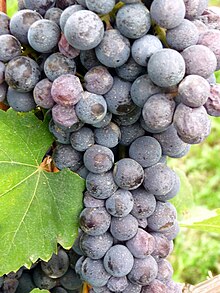
Back Небиоло Bulgarian Nebbiolo Catalan Nebbiolo Czech Неббиоло CV Nebbiolo Danish Nebbiolo German Nebbiolo Spanish Nebbiolo Estonian Nebbiolo Finnish Nebbiolo French
| Nebbiolo | |
|---|---|
| Grape (Vitis) | |
 A cluster of Nebbiolo | |
| Color of berry skin | Noir |
| Species | Vitis vinifera |
| Also called | Nebieul |
| Origin | Piedmont, Italy |
| Notable regions | Piedmont |
| Notable wines | Barolo, Barbaresco, Roero, Gattinara, Ghemme |
| VIVC number | 8417 |
Nebbiolo (/ˌnɛbiˈoʊloʊ/,[1] Italian: [nebˈbjɔːlo]; Piedmontese: nebieul [neˈbjøl]) is an Italian red wine grape variety predominantly associated with its native Piedmont region, where it makes the Denominazione di Origine Controllata e Garantita (DOCG) wines of Barolo, Barbaresco, Gattinara, Ghemme, and Roero, together with numerous DOC wines. Nebbiolo is thought to derive its name from the Italian nebbia or Piedmontese nebia, meaning 'fog'. During harvest, which generally takes place late in October, a deep, intense fog sets into the Langhe region where many Nebbiolo vineyards are located. Alternative explanations refer to the fog-like glaucous veil that forms over the berries as they reach maturity, or that perhaps the name is derived instead from the Italian word nobile, meaning 'noble'.[2] Nebbiolo produces lightly-colored red wines which can be highly tannic in youth with scents of tar and roses. As they age, the wines take on a characteristic brick-orange hue at the rim of the glass and mature to reveal other aromas and flavours such as violets, tar, wild herbs, cherries, raspberries, truffles, tobacco, and prunes. Nebbiolo wines can require years of ageing to balance the tannins with other characteristics.
- ^ "Nebbiolo" (US) and "Nebbiolo". Lexico UK English Dictionary. Oxford University Press. Archived from the original on 2020-03-22.
- ^ Robinson, Jancis; Harding, Julia, eds. (2015). "Nebbiolo". The Oxford Companion to Wine (4th ed.). Oxford University Press. pp. 494–495. ISBN 9780198705383. LCCN 2015941385. OCLC 921140648.